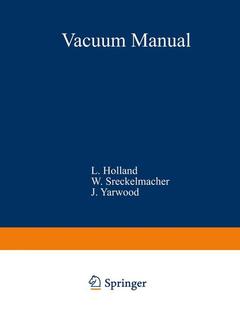Vacuum Manual, Softcover reprint of the original 1st ed. 1974
Langue : Anglais
Auteur : Holland L.

Vacuum apparatus is widely used in research and industrial establishments for providing and monitoring the working environments required for the operation of many kinds of scientific instruments and process plant. The vacuum conditions needed range from the relatively coarse vacuum requirements in applications covering diverse fields such as food packaging, dentistry (investment casting), vacuum forming, vacuum metallur gical processes, vacuum impregnation, molecular distillation, vacuum drying and freeze drying etc. to the other extreme involving the highest possible vacuum as in particle accelerators, space technology -both in simulation and outer space, and research studies of atomically clean surfaces and pure condensed metal films. Vacua commence with the rough vacuum region, i.e. from atmosphere to 100 Pa * passing 6 through medium vacuum of 100 Pa to 0·1 Pa and high vacuum of 0·1 Pa to 1 J.lPa (10- Pa) until ultra high vacuum is reached below 1 J.lPa to the limit of measurable pressure about 12 I pPa (10- Pa).
1. Basic Data.- 1.1 Ultimate pressure(pu).- 1.2 Evolution of gas from materials.- 1.2.1 Outgassing.- 1.2.2 Degassing.- 1.2.3 Vapour pressure.- 1.3 Permeation of gases through solids.- References.- 1.4 Gas flow in vacuum systems.- 1.4.1 Maxwell’s distribution of molecular velocities.- 1.4.2 Mean free path, molecular diameter, viscosity.- 1.4.3 Quantity of gas (as amount of substance).- 1.4.4 Flow regimes.- 1.4.5 Viscous laminar flow in tubes.- 1.4.6 Intensity distribution of gas issuing from tubes under molecular flow conditions.- 1.4.7 Combined systems of tubes and components, conductance of composite systems.- 1.4.8 Transient conditions.- 1.4.9 Pump specifications and tests.- References.- 1.4.10 Conversion and other tables.- 1.5 Pump fluids, sealing compounds and greases.- 1.5.1 Impurities and degradation.- 1.5.2 Pressure measurement problems.- 1.5.3 Pump and trap effects.- 1.5.4 Vapour pressure — measurement and use.- 1.5.5 Pump fluids — chemical types.- 1.5.6 Mineral oil distillates.- 1.5.7 Chlorinated hydrocarbons.- 1.5.8 Hydrocarbon waxes and greases.- 1.5.9 Mineral oil lubricants.- 1.5.10 Hostile conditions.- 1.5.11 Mineral oil lubricants for rotary seals.- 1.5.12 Mineral oil lubricants in dry stage pumps and compressors page.- 1.5.13 Esters of — phthalic, sebacic and phosphoric acid.- 1.5.14 Polyphenyl ethers.- 1.5.15 Silicones and related compounds.- 1.5.16 Perfluoropolyethers.- 1.5.17 Backstreaming characteristics of vacuum pumps.- References.- 2. Vacuum Equipment.- 2.1 Vacuum pumps, valves and accessories.- 2.1.1 Cryopumps.- 2.1.2 Getter ion pumps.- 2.1.3 Magnetless ion pumps.- 2.1.4 Non-evaporable getter pumps.- 2.1.5 Positive displacement pumps.- 2.1.6 Roots pumps.- 2.1.7 Sorption pumps.- 2.1.8 Sputter-ion pumps.- 2.1.9 Steam ejector pumps.- 2.1.10 Titanium sublimation pumps.- 2.1.11 Turbomolecular pumps.- 2.1.12 Vapour pumps.- 2.1.13 Water jet pumps.- 2.1.14 Valves.- 2.1.15 Vacuum accessories.- 2.2 Vacuum instrumentation.- 2.2.1 Thermal conductivity gauges.- 2.2.2 McLeod gauges and compression manometers.- 2.2.3 U tube manometers.- 2.2.4 Mechanical gauges.- 2.2.5 Penning gauges.- 2.2.6 Hot cathode ionization gauges.- 2.2.7 Residual gas analysers.- 2.2.8 Mass spectrometer leak detectors.- 2.2.9 Leak detection instruments using search gas.- 2.2.10 Quartz crystal surface density monitors.- 2.2.11 Thickness monitors.- 2.2.12 Rate meters.- 2.2.13 Vacuum microbalances.- 2.2.14 Optical film thickness monitors.- 2.2.15 Ionization monitors.- 2.2.16 Deposition process controllers.- 2.2.17 Vacuum switching or relay units page.- 2.2.18 Vacuum process controllers.- 2.2.19 Surface analysis instruments.- 2.3 Vacuum process plant and vacuum systems.- 2.3.1 General pumping units.- 2.3.2 Chemical engineering applications of vacuum.- 2.3.3 Vacuum metallurgy.- 2.3.4 Vacuum furnaces.- 2.3.5 Vacuum ovens.- 2.3.6 Electron beam welding equipment.- 2.3.7 Deposition plant: vacuum evaporation.- 2.3.8 Vacuum evaporation special systems, vessel accessories and materials.- 2.3.9 Sputtering plant.- 2.4 Manufacturers’ names and addresses.- 3. Recent Developments in Vacuum Science and Technology.- 3.1 Vacuum pumps; recent developments.- 3.1.1 Introduction.- 3.1.2 Positive displacement pumps.- 3.1.3 Molecular drag pumps: the turbomolecular pump.- 3.1.4 Getter pumps and getter-ion pumps.- 3.1.5 Cryopumps.- References.- 3.2 Vacuum instruments for the analysis of surfaces.- 3.2.1 Introduction.- 3.2.2 Ellipsometry.- 3.2.3 Electron diffraction (LEED and HEED).- 3.2.4 Auger electron spectroscopy (AES).- 3.2.5 Scanning electron microscopy (SEM).- 3.2.6 Electron microprobe.- 3.2.7 Electron spectroscopy for chemical analysis (ESCA).- 3.2.8 Photoelectron spectroscopy.- 3.2.9 Ion scattering spectrometer.- 3.2.10 Ion scattering microscope.- 3.2.11 Secondary ion mass spectrometer (SIMS).- 3.2.12 Static SIM.- 3.2.13 Ion imaging (SIM).- 3.2.14 Secondary ion microprobe.- References.- 3.3 Ion impact sputtering: particle emission related to apparatus design and thin film growth.- 3.3.1 Introduction.- 3.3.2 Physical sputtering.- 3.3.3 Basic types of sputtering system.- 3.3.4 Factors influencing film growth and deposition rate page.- 3.3.5 Vacuum system design and partial pressure monitoring.- References.- Manufacturers’ Index.- Equipment Index.- Advertisers’ Index.
Date de parution : 04-2012
Ouvrage de 428 p.
18.9x24.6 cm
Disponible chez l'éditeur (délai d'approvisionnement : 15 jours).
Prix indicatif 52,74 €
Ajouter au panierMots-clés :
engine; evolution; flow; fluid; furnace; growth; instruments; laminar flow; mass; material; packaging; scanning; scattering; simulation; thin films
© 2024 LAVOISIER S.A.S.



